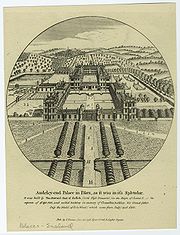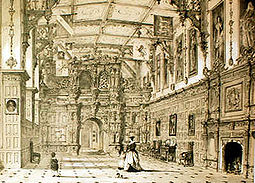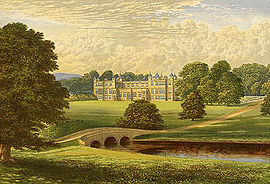
Audley End House
Encyclopedia

Saffron Walden
Saffron Walden is a medium-sized market town in the Uttlesford district of Essex, England. It is located north of Bishop's Stortford, south of Cambridge and approx north of London...
, Essex
Essex
Essex is a ceremonial and non-metropolitan county in the East region of England, and one of the home counties. It is located to the northeast of Greater London. It borders with Cambridgeshire and Suffolk to the north, Hertfordshire to the west, Kent to the South and London to the south west...
, south of Cambridge
Cambridge
The city of Cambridge is a university town and the administrative centre of the county of Cambridgeshire, England. It lies in East Anglia about north of London. Cambridge is at the heart of the high-technology centre known as Silicon Fen – a play on Silicon Valley and the fens surrounding the...
, England
England
England is a country that is part of the United Kingdom. It shares land borders with Scotland to the north and Wales to the west; the Irish Sea is to the north west, the Celtic Sea to the south west, with the North Sea to the east and the English Channel to the south separating it from continental...
. It was once a palace in all but name and renowned as one of the finest Jacobean
Jacobean architecture
The Jacobean style is the second phase of Renaissance architecture in England, following the Elizabethan style. It is named after King James I of England, with whose reign it is associated.-Characteristics:...
houses in England. Audley End is now only one-third of its original size, but is still large, with much to enjoy in its architectural features and varied collections. It is currently in the stewardship of English Heritage
English Heritage
English Heritage . is an executive non-departmental public body of the British Government sponsored by the Department for Culture, Media and Sport...
though remains the family seat of the Lords Braybrooke.
The nearby Audley End railway station
Audley End railway station
Audley End railway station serves the small village of Wendens Ambo and the nearby town of Saffron Walden. The station is named after the manor of Audley End in Essex. There was formerly a platform at the east end of the station for a branch line to Saffron Walden, though this was closed in 1964...
is named after Audley End House.
History

Benedictine
Benedictine refers to the spirituality and consecrated life in accordance with the Rule of St Benedict, written by Benedict of Nursia in the sixth century for the cenobitic communities he founded in central Italy. The most notable of these is Monte Cassino, the first monastery founded by Benedict...
monastery (Walden Abbey
Walden Abbey
Walden Abbey was a Benedictine monastery in Saffron Walden, Essex, England founded by Geoffrey de Mandeville, 1st Earl of Essex between 1136 and 1143. Originally a priory, it was elevated to the status of an abbey in 1190....
), granted to the Lord Chancellor
Lord Chancellor
The Lord High Chancellor of Great Britain, or Lord Chancellor, is a senior and important functionary in the government of the United Kingdom. He is the second highest ranking of the Great Officers of State, ranking only after the Lord High Steward. The Lord Chancellor is appointed by the Sovereign...
Sir Thomas Audley
Thomas Audley, 1st Baron Audley of Walden
Thomas Audley, 1st Baron Audley of Walden, KG, PC, KS , Lord Chancellor of England, born in Earls Colne, Essex, the son of Geoffrey Audley, is believed to have studied at Buckingham College, Cambridge...
in 1538 by Henry VIII
Henry VIII of England
Henry VIII was King of England from 21 April 1509 until his death. He was Lord, and later King, of Ireland, as well as continuing the nominal claim by the English monarchs to the Kingdom of France...
. It was converted to a domestic house for him, known as Audley Inn. This dwelling was later demolished by his grandson, Thomas Howard
Thomas Howard, 1st Earl of Suffolk
Admiral Thomas Howard, 1st Earl of Suffolk, KG, PC was a son of Thomas Howard, 4th Duke of Norfolk by his second wife Margaret Audley, Duchess of Norfolk, the daughter and heiress of the 1st Baron Audley of Walden....
(the first Earl of Suffolk
Earl of Suffolk
Earl of Suffolk is a title that has been created four times in the Peerage of England. The first creation, in tandem with the creation of the title of Earl of Norfolk, came before 1069 in favour of Ralph the Staller; but the title was forfeited by his heir, Ralph de Guader, in 1074...
and Lord Treasurer), and a much grander mansion was built, primarily for entertaining King James I
James I of England
James VI and I was King of Scots as James VI from 24 July 1567 and King of England and Ireland as James I from the union of the English and Scottish crowns on 24 March 1603...
.
The layout reflects the processional route of the King and Queen, each having their own suite of rooms. It is reputed that Thomas Howard told King James he had spent some £200,000 on creating this grand house, and it may be that the King had unwittingly contributed. In 1619, Thomas and his wife were found guilty of embezzlement and sent to the Tower of London
Tower of London
Her Majesty's Royal Palace and Fortress, more commonly known as the Tower of London, is a historic castle on the north bank of the River Thames in central London, England. It lies within the London Borough of Tower Hamlets, separated from the eastern edge of the City of London by the open space...
. However, a huge fine secured their release, but Howard died in disgrace at Audley End in 1626.
At this time, the house was on the scale of a great royal palace, and soon became one after Charles II
Charles II of England
Charles II was monarch of the three kingdoms of England, Scotland, and Ireland.Charles II's father, King Charles I, was executed at Whitehall on 30 January 1649, at the climax of the English Civil War...
bought it in 1668 for £50,000, for use as a home when attending the races at Newmarket. It was returned to the Suffolks in 1701.
Over the next century, the house was gradually demolished until it was reduced to its current size. However, the main structure has remained little altered since the main front court was demolished in 1708, and the east wing came down in 1753. Some rooms have been substantially remodelled, though, especially the huge Hall.

John Griffin Whitwell, 4th Baron Howard de Walden
Field Marshal John Griffin Whitwell, 4th Baron Howard de Walden, 1st Baron Braybrooke, KB was a British nobleman and soldier.-Military career:...
, later fourth Baron Howard de Walden
Baron Howard de Walden
Baron Howard de Walden is a title in the Peerage of England. It was created by writ of summons, by Queen Elizabeth I for Admiral Lord Thomas Howard, a younger son of the 4th Duke of Norfolk, in 1597. The title was reportedly granted for the Admiral's role in the defeat of the Spanish Armada in 1588...
and first Baron Braybrooke
Baron Braybrooke
Lord Braybrooke, Baron of Braybrooke, in the County of Northampton, is a title in the Peerage of Great Britain. It was created in 1788 for John Whitwell, 4th Baron Howard de Walden, with remainder to his kinsman Richard Neville-Aldworth...
, introduced sweeping changes before he died in 1797. In 1762, Sir John commissioned Capability Brown
Capability Brown
Lancelot Brown , more commonly known as Capability Brown, was an English landscape architect. He is remembered as "the last of the great English eighteenth-century artists to be accorded his due", and "England's greatest gardener". He designed over 170 parks, many of which still endure...
to landscape the parkland, and Robert Adam
Robert Adam
Robert Adam was a Scottish neoclassical architect, interior designer and furniture designer. He was the son of William Adam , Scotland's foremost architect of the time, and trained under him...
to design new reception rooms on the house's ground floor, which he did in the style of the 18th century with a formal grandeur. The Great Drawing Room proved problematic as it had to be the grandest room for receiving guests, but it possessed a very low ceiling, and this was considered most undesirable at that time. Robert Adam solved the problem to a large extent by making the furniture unusually small and lowering the chair rail. His design of the Little Drawing Room for the Ladies was exceedingly odd, based on the style of ancient Rome, and Lady Griffin had difficulty moving between the columns when dressed in her evening gown.

Richard Griffin, 3rd Baron Braybrooke
Richard Griffin, 3rd Baron Braybrooke , known as Richard Neville until 1797 and as the Hon. Richard Griffin between 1797 and 1825, was a British Whig politician and literary figure.-Background and education:...
, who inherited house and title in 1825, installed most of the house's huge picture collection, filled the rooms with furnishings, and reinstated something of the original Jacobean feel to the State Rooms.
Audley End was offered to the government during the Dunkirk evacuation but the offer was declined due to the lack of facilities at the house. It was later requisitioned in March 1941. It was initially used as a camp by a small number of units before being turned over to the Special Operations Executive
Special Operations Executive
The Special Operations Executive was a World War II organisation of the United Kingdom. It was officially formed by Prime Minister Winston Churchill and Minister of Economic Warfare Hugh Dalton on 22 July 1940, to conduct guerrilla warfare against the Axis powers and to instruct and aid local...
. The SOE initially used the house as a general holding camp before using it for the Polish
Poland
Poland , officially the Republic of Poland , is a country in Central Europe bordered by Germany to the west; the Czech Republic and Slovakia to the south; Ukraine, Belarus and Lithuania to the east; and the Baltic Sea and Kaliningrad Oblast, a Russian exclave, to the north...
branch of the SOE. A memorial to the 108 Poles who died in the service stands in the main drive. After the war, the ninth Lord Braybrooke
Baron Braybrooke
Lord Braybrooke, Baron of Braybrooke, in the County of Northampton, is a title in the Peerage of Great Britain. It was created in 1788 for John Whitwell, 4th Baron Howard de Walden, with remainder to his kinsman Richard Neville-Aldworth...
resumed possession, and in 1948 the house was sold to the Ministry of Works, the predecessor of English Heritage. Lord Braybrooke moved to the Abbey House in the grounds of Audley End, an irregular L-shaped two-storey house with an early 17th century timber-framed and 19th century brick core. It was remodelled by Sir Albert Richardson
Albert Richardson
Sir Albert Edward Richardson K.C.V.O., F.R.I.B.A, F.S.A., was a leading English architect, teacher and writer about architecture during the first half of the 20th century...
and Eric Houfe in the 1950s and then enlarged to three times its former size by Philip Jebb in 1967-70 for the Hon. Robin Neville. Symmetrical north front with two canted bay windows in the centre. The building history is most apparent from the south, where the gables of the first house can be seen behind those of the 19th century rear wing. The house has interior decoration in Classical style
Classical architecture
Classical architecture is a mode of architecture employing vocabulary derived in part from the Greek and Roman architecture of classical antiquity, enriched by classicizing architectural practice in Europe since the Renaissance...
by Dudley Poplack.
Gardens and grounds

Capability Brown
Lancelot Brown , more commonly known as Capability Brown, was an English landscape architect. He is remembered as "the last of the great English eighteenth-century artists to be accorded his due", and "England's greatest gardener". He designed over 170 parks, many of which still endure...
parkland still includes many of the mock-classical monuments, although some are not in the care of English Heritage. The grounds are divided by the River Cam
River Cam
The River Cam is a tributary of the River Great Ouse in the east of England. The two rivers join to the south of Ely at Pope's Corner. The Great Ouse connects the Cam to England's canal system and to the North Sea at King's Lynn...
, which is crossed by several ornate bridges, and a main road which follows the route of a Roman road
Roman road
The Roman roads were a vital part of the development of the Roman state, from about 500 BC through the expansion during the Roman Republic and the Roman Empire. Roman roads enabled the Romans to move armies and trade goods and to communicate. The Roman road system spanned more than 400,000 km...
. The park beyond the river is frequently used for open air concerts. There is also a miniature circular railway in the grounds.
The walled kitchen garden
Kitchen garden
The traditional kitchen garden, also known as a potager, is a space separate from the rest of the residential garden - the ornamental plants and lawn areas...
in its grounds was painstakingly restored by Garden Organic
Garden Organic
Garden Organic, formerly known as the Henry Doubleday Research Association , is the UK's leading organic growing charity dedicated to researching and promoting organic gardening, farming and food.-History:...
, the UK's leading organic growing charity, in 1999 from an overgrown, semi-derelict state. Renovated to its former glory it now looks as it would have done in late Victorian times; full of vegetables, fruits, herbs and flowers.

